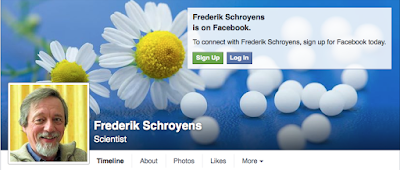Dr. Frederik Schroyens. Gent, Belgium. First day of the summer, 1993
Panoramic
splendor awaits the lonely mountain climber as they reach the summit.
Applause meets the marathon runner when they approach the finish line.
There is a glow of joy whenever a person gets close to a goal they set
in life.
However, nothing compares to the happiness a whole
team feels when a common goal is achieved. Such is the happiness we have
experienced on the eve of printing Synthesis.
When I became homeopathic coordinator of the RADAR
project, one of my first actions was to outline a "Request for
collaboration". In 1986, we sent this charter to all leading homeopaths
who were concerned with the evolution of homeopathy and computer
science.
The majority of those homeopaths reacted positively
and since then this team has achieved different milestones. The printing
of Synthesis is such a milestone. I will not let the opportunity go by
without acknowledging them on paper. In the beginning, there was only a
small group of Belgian homeopaths gathered around Professor Jean
Fichefet.
This initial "neighborhood initiative" triggered the
enthusiasm of homeopaths all over the globe, so that today nearly 2000
are using RADAR. It is to these RADAR users and especially to the early
adopters that my appreciation goes. Many of them have been loyal
collaborators in the creation and correction of successive versions of
Synthesis. Other homeopaths have contributed to the development of
Synthesis as a concept and to the growth of the homeopathic information
contained therein.
Among them, I would like to thank for their
inspiration, support and concrete help: Alfonso Masi Elizalde from
Argentina; Filip DeGroote, Patrick Detand, Alfons Geukens, Jean-Claude
Gregoire, Jacques Imberechts, Michel Paulus, Jean-Francois Vermeire from
Belgium; Claudio Araujo, Hylton Luz from Brazil; Steve Olsen from
Canada; Per Neesgard from Denmark; Jeremy Sherr from England; Andre
Dieudonne, Michel Zala from France; Rainer Dierken, Uwe Garbers, Peter
Friedrich, Thomas Lowes, Thomas von Reumont, Friedrich Witzig from
Germany; Peter Garzonis, George Papaphilippou, George Vithoulkas from
Greece; Jean-Pierre Jansen, Rene Otter, Arjen Pasma, Lex Rutten, Henk
vanMunster, Eric Van Woensel from Holland; Carlo Cenerelli, Massimo
Mangialavori, Carlo Rezzani, Carlo Solerio from Italy; Guy Loutan from
Switzerland; Gunnar Janson from Sweden, Dean Crothers, Ahmed Currim,
Linda Johnston, and Ananda Zaren from the USA.
RADAR began as a research project at the University
of Namur (Belgium) under the supervision of Jean Fichefet. As the
interest in the program rose quickly, it became necessary to entrust the
organization and international representation to professional and
dedicated people. First Eric Anbergen, and now, since 1990, Dale
Emerson, and his staff have taken care of all organizational and
administrative aspects. A group of "representatives" in more than 30
countries assists them. Thanks to these people, a channel was formed
through which our work could reach many more colleagues.
We could write a whole book on the role computer
science has played in the development of Synthesis. Philippe
Santantonio, chief programmer, and his colleagues are largely
responsible for the precision and speed with which Synthesis has reached
its current level. As Synthesis is a large collection of data, encoding
is a necessary part of the job. Thanks especially to Katelijne
Vanhoutte and Gerd Van Brandt and all those who have worked with them or
preceded them in their efforts to get the raw substance ready.
The Hahnemann Institut (Germany) has undertaken to
print Synthesis in German. The plan was to print the fourth edition, but
due to their request we decided to improve the quality first. Their
solid conviction that quality outweighs any claims about quantity has
supported us in the creation of version 5, which has "only" 3,000
additions more than its predecessor. Reinhard Rose and his collaborators
have been of great help in double-checking many of the rubrics. He has
also generated great enthusiasm in the German speaking countries so
that, as we go to print, a high number of subscriptions to buy the book
have already been made. This is also due to the full support that some
schools gave us by subscribing en masse for the German edition of
Synthesis. We would like to thank the directors of these schools. Their
trust has been the greatest incentive to do the job.
Peter Vint has been responsible for the German
translation, but also in great part for the creation of consistency
throughout other editions; since the shaping of this new edition of
Synthesis (in English) has been so intermingled with the preparation of
the printed German version. His sharp, critical mind and his love for
homeopathy make him one of the leading professional homeopathic
researchers and translators. His reputation is well known through his
work on the translation and correction of Clarke and we are happy to
have him at our side for this project.
One last thank you for those who have helped with
the finishing touch, reading through the English manuscript: Dale
Emerson (Australia), Francoise Becquey (Canada), Nick Churchill
(England), Gary Bachman (USA) and especially Joan Bielunas, my dedicated
American sister-in-law. Altogether, this new concept of Repertory was
born out of dozens of letters, hundreds of meetings, and thousands of
hours of conversations. May this missive serve as a starting point for
your reflections on the topic. Your ideas and your criticism are
welcome.



